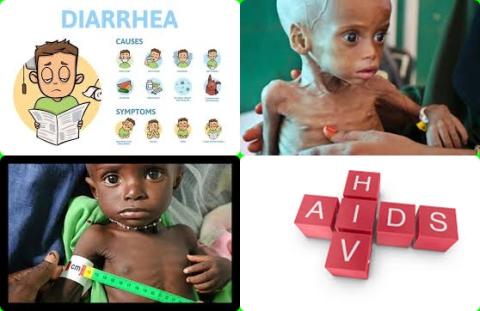
Objectives:
Malnutrition underlies 45% of under-5 deaths globally. Severe acute malnutrition (SAM) is the most serious form of undernutrition, characterized by wasting with or without edema. Mortality remains high (10%-40%) among children requiring hospitalization for complicated SAM. Therefore, this review article has been conducted.
What are the risk factors of inpatient mortality in children with severe acute malnutrition?
Study design:
This review article included 28 studies, of which 19 studies included all children with severe acute malnutrition and 9 evaluated subgroups of children with SAM [diarrhea (n = 4), pneumonia (n = 2), kwashiorkor (n = 1), shigellosis (n = 1) and those with blood cultures (n = 1)].
All 19 main studies were from 8 countries across Africa, with a median of 400 children per study. The majority (15 of 19; 79%) were single-center studies.
9 factors were included in the meta-analysis, stratified by HR and OR.
Results and conclusions:
The investigators found the mean inpatient mortality rate was 15.7% [95% CI = 10.4% to 21.0%] and HIV prevalence ranged from 2.1% to 51%.
The investigators found HIV infection significantly increased risk of inpatient mortality in children with severe acute malnutrition with 332% [HR = 4.32, 95% CI = 2.31 to 8.08].
The investigators found weight-for-height z score (WHZ) significantly decreased risk of inpatient mortality in children with severe acute malnutrition with 56% [OR = 0.44, 95% CI = 0.24 to 0.80].
The investigators found diarrhea significantly increased risk of inpatient mortality in children with severe acute malnutrition with 184% [HR = 2.84, 95% CI = 1.40 to 5.75].
The investigators found pneumonia significantly increased risk of inpatient mortality in children with severe acute malnutrition with 89% [HR = 1.89, 95% CI = 1.19 to 3.02].
The investigators found presence of shock significantly increased risk of inpatient mortality in children with severe acute malnutrition with 267% [HR = 3.67, 95% CI = 2.24 to 6.03].
The investigators found lack of appetite significantly increased risk of inpatient mortality in children with severe acute malnutrition with 116% [HR = 2.16, 95% CI = 1.48 to 3.16].
The investigators found no association between both child age and sex and risk of inpatient mortality in children with severe acute malnutrition.
The investigators concluded HIV infection, diarrhea, pneumonia, shock, lack of appetite and lower weight-for-height z score (WHZ) are independent predictors of inpatient mortality in children with severe acute malnutrition. These factors may help to risk-stratify children being hospitalized with complicated severe acute malnutrition.
Original title:
Predictors of inpatient mortality among children hospitalized for severe acute malnutrition: a systematic review and meta-analysis by Karunaratne R, Sturgeon JP, […], Prendergast AJ.
Link:
https://www.ncbi.nlm.nih.gov/pmc/articles/PMC7528552/
Additional information of El Mondo:
Find more information/studies on malnutrition right here.